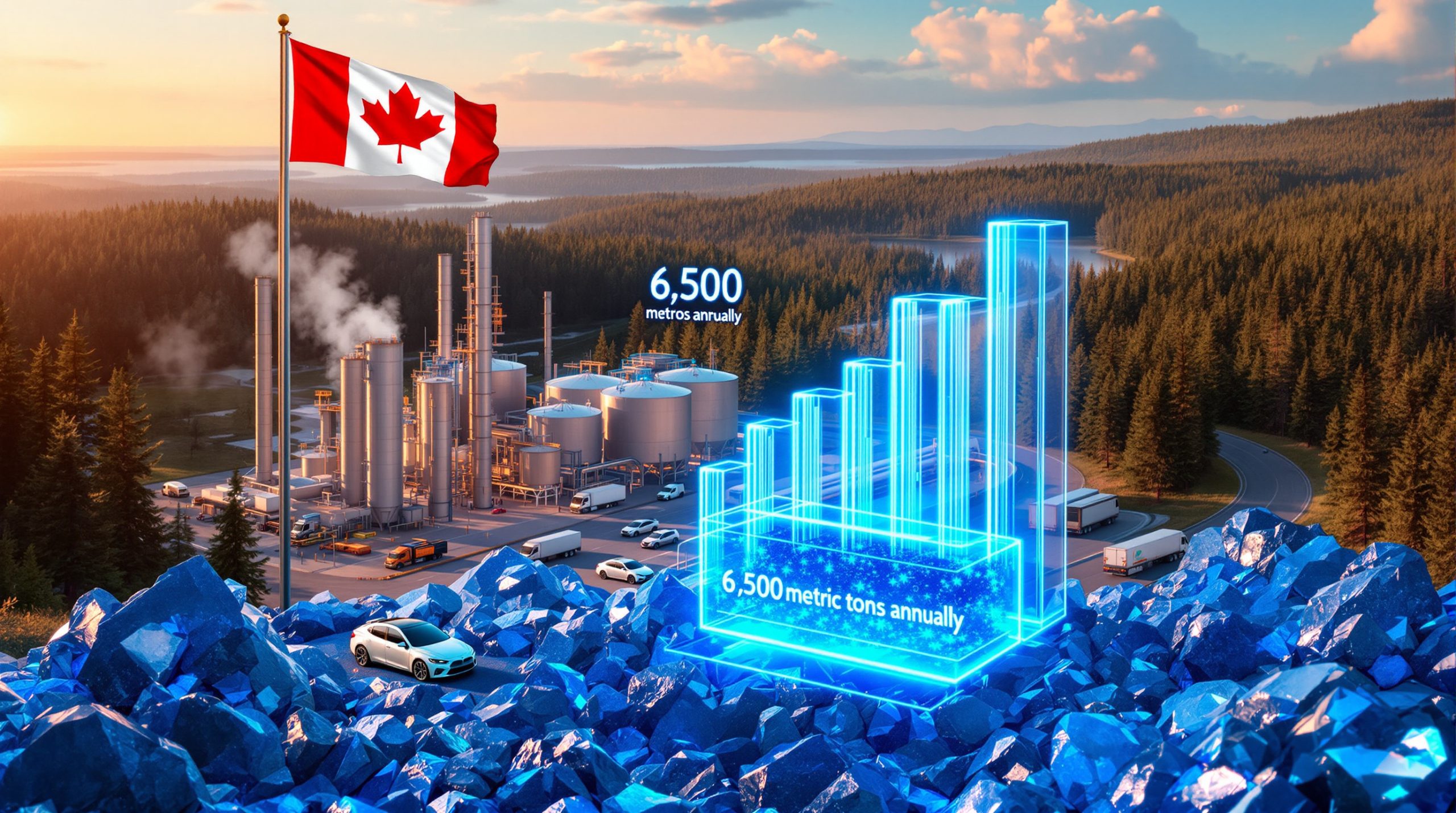Flash Joule Heating Technology: Revolutionizing Metal Recovery
Flash Joule Heating (FJH) represents a groundbreaking approach to metal extraction that utilizes rapid electrical pulses to efficiently process materials. This innovative technology generates extremely high temperatures within milliseconds, enabling effective separation of valuable metals from complex waste streams without requiring extensive chemical processing.
MTM Critical Metals recovers antimony from e-waste using this technology, creating a sustainable alternative to traditional mining and refining methods that typically generate significant environmental impacts.
The process works by applying high-voltage electrical pulses to waste materials, creating intense heat that breaks chemical bonds and separates metals based on their electrical conductivity and melting points. This targeted approach allows for selective recovery of specific metals like antimony from complex material matrices.
Advantages Over Traditional Recovery Methods
Traditional metal recovery from e-waste typically involves chemical leaching or smelting processes that generate significant emissions and waste. FJH technology offers several compelling advantages:
- Reduced chemical usage with minimal environmental impact compared to acid leaching methods
- Lower energy consumption per unit of metal recovered, improving overall efficiency
- Higher recovery rates (98%) for specific metals like antimony
- Ability to process complex, mixed waste streams efficiently without extensive pre-sorting
- Minimal waste generation during processing, reducing disposal challenges
According to MTM's technical data, their FJH system can achieve recovery rates that significantly outperform conventional extraction methods while using a fraction of the energy and chemicals typically required.
"Our Flash Joule Heating technology represents a paradigm shift in how we approach metal recovery from complex waste streams," explains Michael Walshe, MTM CEO. "Achieving 98% recovery of antimony at over 3% grade from domestic urban feedstock is particularly significant given the US currently has no meaningful domestic antimony production."
Why Antimony Recovery from E-Waste Matters
Antimony has emerged as one of the most critically important metals for advanced applications, yet it remains largely under the radar in public discourse about strategic materials. This metallic element plays a vital role in multiple high-tech and defense applications, making its secure supply chain increasingly important.
The Strategic Importance of Antimony
Antimony has secured its place as a critical metal with significant strategic applications across multiple sectors:
- Defense applications: Used in armor-piercing alloys and ballistic materials
- Flame retardant systems: Essential for military and civilian fire safety applications
- Electronics manufacturing: Critical component in soldering materials, particularly in legacy systems
- Energy storage technologies: Used in certain battery technologies and emerging energy systems
- Medical applications: Utilized in treatments for parasitic diseases and other medical compounds
The U.S. Departments of Defense and Energy have both classified antimony as a critical material due to its irreplaceable properties in defense applications and energy systems. The recent critical minerals order has further highlighted the importance of securing domestic supply chains for these materials. Unlike some other metals, antimony has few viable substitutes in many of its key applications.
Supply Challenges and Market Volatility
The antimony market faces several significant challenges that make alternative sources increasingly valuable:
- Price volatility: Increases of over 200% in the past year due to supply constraints
- Concentrated production: China controls approximately 53% of global antimony production
- Supply vulnerability: No significant domestic production exists in the United States
- Geopolitical risk: Recent tensions have highlighted critical supply chain vulnerabilities
- Limited recycling infrastructure: Few systems exist globally for antimony recovery
This combination of factors has created an urgent need for domestic antimony recovery capabilities, particularly from secure sources like e-waste that aren't subject to international supply disruptions. The U.S. government has recognized this need through its strategic antimony loan programs designed to boost domestic production.
MTM Critical Metals' Breakthrough Results
MTM's recent testing demonstrates exceptional performance metrics that position the company at the forefront of antimony recovery technology.
Record-Breaking Recovery Rates
The company's latest processing runs have achieved remarkable results:
- 98% recovery rate of antimony from processed e-waste
- 3.13% antimony grade extracted from printed circuit board feedstock
- Significantly higher concentration than typical mined ore (0.5-0.7%)
- Successful extraction from the same feedstock previously used for gold, silver, and copper recovery
These technical achievements represent a significant breakthrough in urban mining capabilities, demonstrating that e-waste can be a more concentrated source of antimony than primary mining operations. The company has applied innovative extraction technology principles to the antimony recovery process with impressive results.
Comparison to Traditional Mining Operations
The 3.13% antimony grade achieved by MTM represents a substantial improvement over conventional mining, as shown in this comparative analysis:
| Source | Typical Antimony Grade | Recovery Rate | Environmental Impact |
|---|---|---|---|
| MTM E-Waste Processing | 3.13% | 98% | Minimal new land disturbance |
| Primary Mining Deposits | 0.5-0.7% | 70-85% | Significant land disturbance |
| Secondary Recovery Methods | 1-2% | 60-75% | Moderate impact |
This data highlights the efficiency of MTM's process not only in terms of recovery rates but also in delivering a higher-grade product with significantly reduced environmental footprint compared to traditional mining operations. According to recent reports on high-grade antimony recovery, MTM's approach represents a major advancement in recycling technology.
"The strategic role of antimony in defense and battery applications was a consistent theme during recent meetings in Washington," notes Michael Walshe. "Our ability to recover high-grade antimony from domestic e-waste addresses a critical supply vulnerability."
MTM's Commercial Development Strategy
MTM Critical Metals has established a comprehensive strategy to scale its technology from laboratory success to commercial operations.
Secured Feedstock and Processing Infrastructure
The company has established key operational foundations to support its growth:
- Long-term supply agreements securing over 1,100 tonnes of e-waste feedstock annually
- Pre-permitted demonstration site in Texas for scaling operations
- Processing capability for legacy and industrial-grade electronics with higher antimony content
- Multi-metal recovery systems that can extract several valuable metals from the same feedstock
This infrastructure provides MTM with a secure operational base and reliable feedstock sources, critical factors for scaling any metal recovery operation.
Strategic Government Engagement
The company is actively pursuing government partnerships to accelerate commercialization:
- Ongoing discussions with US government agencies for potential funding support
- Alignment with Department of Defense critical materials priorities
- Engagement with Department of Energy domestic supply initiatives
- Positioning as a solution to US strategic metal supply challenges
These government relationships could potentially accelerate MTM's path to commercial scale while addressing national security concerns around antimony supply. The company is well-positioned to benefit from innovative mining trends that emphasize resource efficiency and circular economy principles.
E-Waste as a Premium Antimony Source
Electronic waste has emerged as a particularly attractive source for antimony recovery, offering several advantages over traditional mining operations.
High Concentration in Specific E-Waste Streams
Antimony appears in significant quantities in several specific e-waste categories:
- Legacy servers and telecommunications equipment: Often contain tin-lead-antimony solders
- Military hardware and specialized electronics: Utilize antimony in flame retardants and specialized components
- Older consumer electronics: Contain specific flame retardant requirements with high antimony content
- Industrial control systems: Specialized equipment often contains antimony-based components
The concentration of antimony in these specific waste streams can be significantly higher than in primary ore deposits, making targeted e-waste processing economically attractive.
The Urban Mining Advantage
Recovering antimony from e-waste offers several strategic advantages over traditional mining:
- Reduced environmental impact compared to primary mining operations
- Lower capital investment requirements than establishing new mines
- Proximity to end markets, reducing transportation costs and supply chain vulnerabilities
- Ability to recover multiple valuable metals simultaneously from the same material stream
- Contribution to circular economy objectives and reduced landfill waste
This "urban mining" approach transforms what was previously considered waste into a valuable domestic resource for critical materials, reducing dependence on foreign suppliers while addressing growing e-waste management challenges. The implementation of a sustainable recycling process is central to MTM's business model.
Market Potential for Recovered Antimony
The market outlook for antimony recovered from e-waste appears particularly promising due to both supply constraints and growing demand across multiple sectors.
Growing Demand Across Multiple Sectors
Antimony demand continues to increase in several key markets:
- Defense sector requirements for specialized alloys and ballistic materials
- Flame retardants for building materials and electronics (largest current use)
- Lead-acid battery manufacturing for automotive and industrial applications
- Emerging applications in next-generation electronics and semiconductors
- Medical applications and pharmaceutical compounds for specialized treatments
As applications for antimony continue to expand, particularly in high-tech and defense sectors, secure supply sources become increasingly valuable.
Price Trends and Economic Viability
The economics of antimony recovery have improved significantly in recent years:
- Current market prices approximately 4x higher than five years ago
- Premium pricing for domestically sourced materials in strategic applications
- Additional value from co-recovered metals in the same process
- Potential regulatory incentives for domestic critical materials production
These favorable economics, combined with the technical success MTM has demonstrated, create a compelling case for commercial-scale antimony recovery from e-waste. As detailed in market analysis of antimony recovery from e-waste, the financial metrics support continued investment in this technology.
Sustainability Benefits of E-Waste Recovery
Beyond the economic and strategic advantages, MTM's approach offers significant environmental benefits that align with broader sustainability goals.
Environmental Benefits of E-Waste Recovery
MTM's approach offers significant environmental advantages compared to traditional mining:
- Diversion of hazardous materials from landfills where they could leach into groundwater
- Reduction in mining-related environmental impacts including land disturbance and habitat loss
- Lower carbon footprint compared to energy-intensive primary production
- Conservation of virgin resources through circular economy principles
- Reduced transportation emissions through localized processing
These environmental benefits position urban mining as an environmentally responsible approach to meeting critical material needs.
Addressing E-Waste Management Challenges
The technology helps address growing e-waste problems that have become a significant global challenge:
- Processing capability for difficult-to-recycle components that often end up in landfills
- Recovery of multiple metals from complex waste streams that would otherwise be lost
- Scalable solution for managing increasing global e-waste volumes
- Potential for localized processing reducing transportation impacts
By extracting value from e-waste, MTM's technology creates economic incentives for proper e-waste collection and processing, helping address the broader challenge of electronic waste management.
"Our process not only recovers valuable antimony but also helps solve the growing challenge of e-waste management," states MTM's environmental director. "It's a win-win for resource security and environmental protection."
MTM Critical Metals' Future Roadmap
MTM has outlined an ambitious but structured path forward to scale its technology and establish commercial operations.
Scaling and Commercialization Strategy
The company has outlined several key next steps in its development plan:
- Expansion of processing capacity at the Texas demonstration site
- Optimization of the FJH process for specific feedstock types to maximize yields
- Development of additional metal recovery capabilities beyond antimony
- Establishment of commercial-scale operations with expanded capacity
This phased approach allows MTM to demonstrate the technology at increasingly larger scales while refining the process parameters for optimal performance.
Potential Industry Partnerships
The company is exploring strategic relationships to accelerate commercialization:
- Supply agreements with major electronics manufacturers for end-of-life products
- Collaboration with defense contractors for specialized applications
- Integration with existing e-waste collection networks to ensure feedstock supply
- Technology licensing opportunities in international markets
These partnerships could provide MTM with additional resources, market access, and validation of its technology while accelerating adoption across multiple sectors.
Frequently Asked Questions About Antimony Recovery from E-Waste
What makes antimony a critical metal?
Antimony is designated as critical due to its essential role in defense applications, limited domestic production in Western countries, and concentrated global supply chains primarily controlled by China. Its unique properties make it difficult to substitute in many applications, particularly in flame retardants and specialized alloys used in defense systems. The U.S. government has formally classified antimony as a critical material due to these supply vulnerabilities.
How does urban mining compare to traditional mining?
Urban mining recovers metals from waste streams and discarded products rather than extracting virgin materials from the earth. This approach typically requires less energy, produces fewer emissions, and generates less waste than traditional mining while reducing dependence on geopolitically sensitive supply chains. For metals like antimony, urban mining can actually access higher grades (3%+) than are typically found in primary ore deposits (0.5-0.7%).
What types of e-waste contain the highest antimony concentrations?
Legacy servers, telecommunications equipment, military hardware, and older consumer electronics typically contain the highest antimony concentrations, primarily in solder and flame-retardant components. Industrial control systems and specialized equipment may also contain significant amounts of antimony in various forms. MTM specifically targets these high-concentration feedstocks to maximize recovery efficiency.
How does the flash joule heating process work?
Flash joule heating applies extremely high-voltage electrical pulses to waste materials, creating intense heat in milliseconds. This rapid heating breaks chemical bonds and allows for separation of metals without extensive chemical processing. The technology can selectively target specific materials based on their electrical conductivity and melting points, making it particularly effective for complex mixed material streams like e-waste.
Ready to Capitalise on the Next Critical Minerals Breakthrough?
Discover how to stay ahead of transformative mining developments like MTM's antimony recovery innovation with Discovery Alert's proprietary Discovery IQ model, which delivers real-time alerts on significant ASX mineral discoveries directly to subscribers. Explore why major mineral discoveries lead to exceptional market returns by visiting Discovery Alert's dedicated discoveries page and begin your 30-day free trial today.




